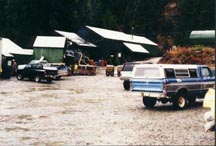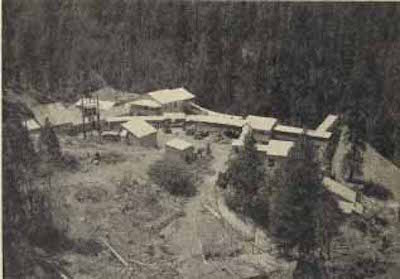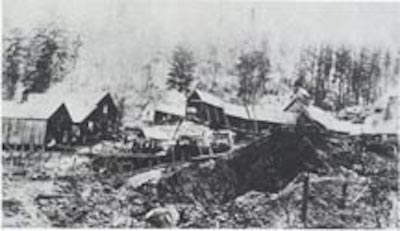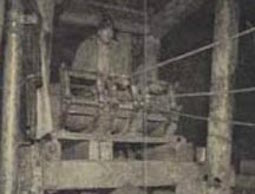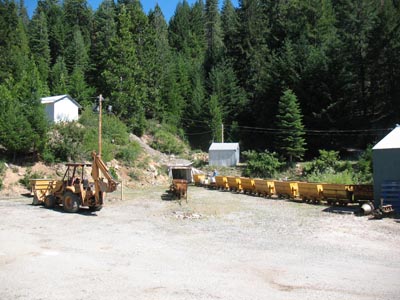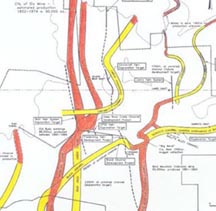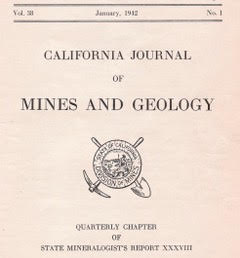The Ruby Mine circa 1940.
(Photo courtesy of L. L. Huelsdonk. From the "California Jounal of Mines and Geology", January 1942.)
The 49'ers discovered the Old Ruby Channel early in the Gold Rush. Prospectors followed a rich path of large gold nuggets up from Downieville to where the Ruby gravels "daylighted" on the hillside above the Yuba River. They named the watercourse that led up the mountain "Slug Canyon" in recognition of the unusually large gold nuggets they found there.By the 1860's the rivers, streams and readily-accessible surface deposits were playing out, so the miners began to tunnel into the mountains to mine the Tertiary Channels buried under the ridges. The early underground mining methods were primitive. In the Ruby Channel, for example, progress was soon halted by water since the miners were working downstream. Advances in technology and engineering -- and the developing science of geology -- needed to occur before "drift" mining in the Ruby Channels would become practical.
The Ruby Mine in 1886.
(Photo courtesy of Jerry Wentling, from"The Lapidary Journal", November 1987.)
The Ruby Tunnel was "portalled" in 1880 and over 2,000 feet of tunnel was driven to access the Old Ruby Channel. Underground placer "drift mining" was in its heyday and the 1880's and 1890's were a highly productive period for the Ruby Mine. On the east side of the current property, the Bald Mountain Extension Company was conducting a comparably large and successful mining operation.In 1891 newspapers reported the discovery of a Ruby Gold Nugget weighing 201 ounces (almost 17 pounds). A nugget weighing about 90 ounces was reported in 1892. The replica of a Ruby specimen from the same period weighing about 180 ounces is in the collection of the California State Mining and Mineral Museum in Mariposa, California.
By the early 1900's work in the Ruby Channels was greatly reduced. However, Walter Lawry, Henry Mott, and others were sinking shafts on the east side of the property into what would come to be known as the Black Channel system. Once again, the technology of the times severely limited the amount of mining the miners were able to accomplish; but these pioneers verified that the channels existed.
At the same time, Willie Wolf was sinking a shaft in the bedrock of the Old Ruby Channel -- over 3,000 feet underground! -- to explore and develop a quartz ledge that had been discovered during the earlier placer mining. Once again, conditions were extremely difficult and Wolf soon shut down his operation.
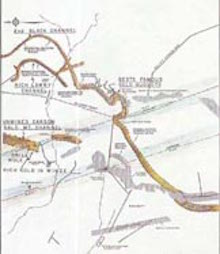
1930's
A map of the Ruby Channel Systems
Only limited work was conducted at the Ruby Mine until the 1930's, when the government raised the price of gold from $20 to $35. C. L. Best, owner of Caterpillar Tractor in San Leandro, California, purchased the mine and hired L. L. Huelsdonk to run it. The Ruby Mine was soon reported by the California State Mineralogist to be among the most modern and well-equipped placer mining facilities in the world.The Post-WWII Years
A miner working an underground slusher in the Black Channel of the Ruby Mine circa 1940.
(Photo courtesy of L. L. Huelsdonk. From the "California Jounal of Mines and Geology", January 1942.)
The years following World War II were difficult for California's gold mines. The post-war boom brought inflation and higher costs while the price of gold was fixed at $35 an ounce. C. L. Best did not reopen the Ruby but sold it after the war. The mine changed hands a number of times and was exploited by a series of "shovel-and-wheelbarrow" operators who salvaged in the existing workings, mostly by mining pillars of gravel left behind by C. L. Best's operation.